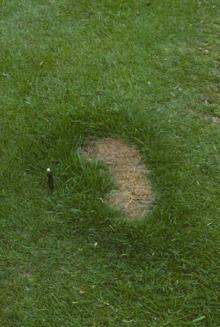Hosts Kentucky bluegrass is more sensitive than other types.
Cause Animal urine does more damage on dry soils, where the salts cannot be easily dispersed. Female dogs are usually more damaging as they urinate on the ground, in the same spot and tend to empty their bladders more completely than males. This results in a higher concentration of acids, salts, ammonium, nitrates and phosphates in those areas. Male dogs tend to urinate on vertical objects including plants but do not empty their bladders nearly as much resulting in less urine distributed in a wider area. The more dilute the urine the less toxic it is to the lawn. Also, pH alone has no effect on lawn burn.
Symptoms Dog injury typically appears on lawns as brown, circular patches a few inches in diameter. These patches may be surrounded in a few days by a ring of darker green, more vigorous grass, resulting from the nitrogen in the urine. Samples of the dead grass placed in a plastic bag will release ammonia, which can be detected by smell. Urine damage can be mistaken for symptoms of several patch-type diseases. Other chemical injury such as fertilizer spills or salt spills can cause similar symptoms but do not release an ammonia odor.
Cultural control
- Overseed damaged spots with a grass seed mix similar to the lawn composition to fill in spots and prevent weed invasion.
- Water spots to help dilute the concentration of urea in the dog's urine.
- Plant more resistant grass species.
- Fence lawn areas off to dog access.
- Fertilize lawn evenly if excessive greening in spots is considered the problem.
References Allard, A.W. 1981. Lawn burn from dog urine. Canine Pract 8: 26-27.
Paradeis, B., Lovas, S., Aipperspach, A., Kazmierczak, A., Boche, M., He, Y., Corrigan, P., Chambers, K., Gao, Y., Norland, J., and DeSutter, T. 2013. Dog-park soils: Concentration and distribution of urine-borne constituents. Urban Ecosystems 16:351-365.




